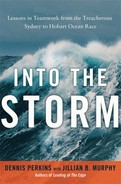10
![]()
Sayonara—The Best Professional Sailors on the Planet
As AFR Midnight Rambler maneuvered before the starting gun, Larry Ellison had his own concerns.1 This was his moment. He was standing proudly in the limelight at Sayonara's wheel, the focus of hundreds of thousands of spectators and television cameras. This was his chance to prove that he had arrived as a world-class ocean racer. But it wouldn't be easy. Ellison would have to constantly tack the boat. A tacking maneuver—changing direction so the bow of the boat passes through the wind and the sails swing to the opposite side—requires timing and coordination. Zigzagging through hundreds of other boats was dicey, and a collision could mean the end of the race.
Ellison was surrounded by some of the finest sailors in the world, but there were two other amateurs aboard Sayonara—Phil Kiely and Lachlan Murdoch. Kiely, the head of Oracle's Australian operations, had grown up in Sydney and had done two Hobarts. His experience was on smaller boats, but he wasn't a complete novice.
Lachlan Murdoch is the son of news mogul Rupert Murdoch. The elder Murdoch had been aboard Sayonara in 1995 and had shown some spunk when he lost the tip of his finger during a practice sail. After the missing piece was reattached, Murdoch declared himself fit to sail, served coffee during the race, and shared Ellison's line honors victory. Murdoch topped off the race by buying drinks for the crew in Hobart.
Now it was Lachlan's turn, but this was a new adventure for the young scion. He was a risk taker and a rock climber, but not a professional sailor. Though he had sailed his own boat in the 1997 Hobart, he was not at the level of Ellison's hired guns. The opportunity to sail on Sayonara arose when he met Ellison at a friend's Fourth of July party. Rupert Murdoch was also there, and Ellison extended an invitation. Rupert couldn't do the race, but he suggested his son. Ellison agreed, and Lachlan enthusiastically accepted.
Except for Lachlan and one other guest, Ellison was surrounded by a superb crew of professional sailors drawn from the ranks of Olympic medalists and New Zealand's national ocean racing team. At least on the water, Ellison was aware of his limitations: “I love working with the Sayonara crew…because I'm not the star. I'm just a pretty good amateur driver. The rest of the Sayonara crew are the best professional sailors on the planet. These guys are unbelievably good at what they do. They're the best.”2
At the top of the hierarchy of professional sailors was Chris Dickson. Dickson was as intensely competitive as Ellison, with an uncompromising commitment to winning. He had won three International Sailing Association Youth World Championships and had skippered the first New Zealand yacht to compete in the America's Cup. He had completed numerous America's Cup campaigns and competed in the 1993 Round the World Whitbread Race. Ellison's search for “the best sailors in the world” led him straight to Dickson, who would be responsible for sailing Sayonara and managing the crew.
Dickson had a reputation as an uncompromising taskmaster, and Sayonara's crew had practiced just as relentlessly as AFR Midnight Rambler. Like Ed Psaltis, Dickson was a perfectionist. With the exception of Ellison, Dickson would scream at anyone who failed to meet his expectations. Unlike Psaltis, however, Dickson was not known for making up after harsh words. His reputation was that of a fanatical perfectionist, unforgiving of himself and others.3
Ellison was at the wheel, but Dickson was standing right behind him shouting out orders. Ellison was doing what he was told, and so far things were going just as planned. The weather was perfect, warm and sunny, not a storm cloud in the sky. The breeze was light and they were surrounded by spectacular scenery. Then things took a turn for the worse.
In spite of the amount of money that Ellison had invested in Sayonara, not all of the high-tech equipment was working perfectly. During one maneuver a special carbon fiber gear broke in one of their main winches. The winch is a critical part of a sailboat. Lines running from the sails wind around the circular drum and enable sailors to quickly adjust the angle of the sail to the wind for maximum speed. Without a winch it would be an impossible task, especially on a boat the size of Sayonara.
Dickson was furious. “How the hell can we break one of our main winches before the goddamn race's even started?”4 Ellison was relieved that he didn't bear the brunt of Dickson's wrath, but there was no time to repair the winch before the start of the race. Maneuvering had to be done slowly and carefully, compounding the challenge of getting a good start.
Dickson made it clear that they should stay away from Nokia, because of their record of colliding with other boats. All Sayonara wanted was a good start, and that's what they got. Ellison was thrilled:
It was a good start. We rounded the first mark ahead of the rest the fleet…. It was just about as perfect sailing as we could get. We had no idea what was going to happen to us over the next three days. If we had, we would've turned left and gone up north to the Great Barrier Reef. That's where all the sensible people having sensible Christmas holidays go. Instead we turned right and raced down the Australian coast toward the island of Tasmania.5
With George Snow and Brindabella close on Ellison's heels, Sayonara was the first boat to sail out of the harbor. With hundreds of thousands of people watching and television cameras focused on the Big Yank Tank, Ellison had made the most of his moment.
